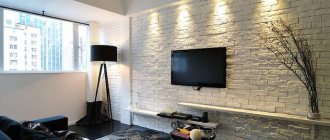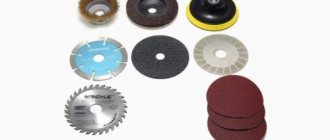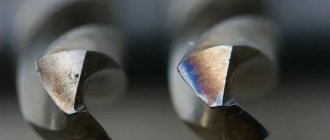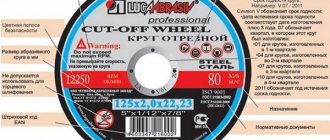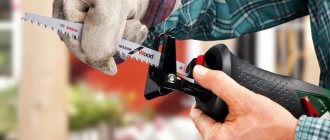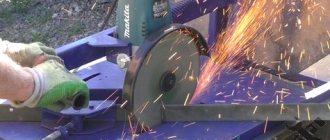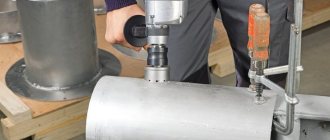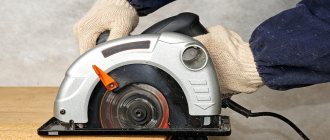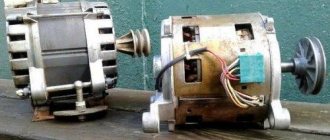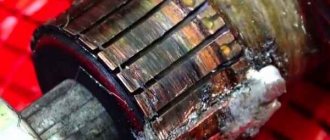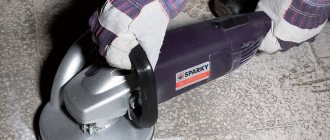What is it used for?
Various devices are used to remove rust or old paint from a metal surface. You can get the job done quickly and efficiently using a grinder and a special brush attachment.
The design is a round base with wire or nylon bristles. The working elements are located evenly around the entire circumference of the cup. The length of the bristles is uniform.
Disc brush for angle grinders, nylon wire with abrasive coating BISON “PROFESSIONAL”
If the wheel is unevenly covered with wire bristles, involuntary vibration of the attachment is observed during grinding. Because of this, the quality of cleaning decreases.
Equipment is selected for an angle grinder taking into account technical indicators. One of the main ones is the number of revolutions per minute. It is unacceptable to use a metal brush with a low speed on an angle grinder with a high rotation speed. The effect of such processing will be minimal. The equipment will quickly fail.
For what purposes are cord brushes used:
- stripping the old protective coating (LCM);
- grinding of metal blanks;
- deburring;
- brushing, roughening of wood blanks;
- cleaning parts before welding;
- removing unnecessary part of the deposited metal from the seams;
- grinding off sharp corners, etc.
Sometimes metal brushes are used as substitutes for abrasive wheels.
Purpose
Among the huge variety of discs for angle grinders, 4 groups of main attachments can be distinguished. They are divided depending on the technological operations performed.
Cut-off
Angle grinder discs are most often used when cutting products from different materials. There are several types of cutting discs:
- Nozzles for metal. Equipment made from electrocorundum. Indicated in blue.
- Attachments for cutting natural stone or concrete. Such discs are made of silicon carbide. Indicated in green. Not suitable for working with red brick or ceramic tiles.
- Equipment used when working with tiles, porcelain stoneware, red brick. Made of metal. The edges are covered with diamond chips. During active operation of metal discs, coolant must be used.
- Nozzles for wood. These are metal discs no different from circular saws.
It is better not to use an angle grinder with a disc for wood. This is due to the fact that circular equipment is extremely dangerous when working with an angle grinder. It often slips off the rotating shaft, jams, and bounces off.
Roughing
Using an angle grinder, metal surfaces are often cleaned of rust, plaque, and paint. To do this, use a nozzle on which a metal wire is fixed. A peeling disc is a product with a brush attached to the outer diameter or a bowl with metal rods sticking out forward.
Grinding
A grinding disc for an angle grinder for metal is called a flap disc. It is used when working with metal and other materials. Separate pieces of sandpaper are attached to it. The size of abrasive particles depends on the required degree of cleaning.
Petal disc for grinder
Sharpening
Most often, sharpening stones are used when working with machine tools. If you don’t have a tool, you can attach a stone for sharpening tools and knives to an angle grinder. Special attachments for power tools with a thickness of at least 0.5 cm are sold.
Main characteristics of brushes
The base of the brush is a circle with a hole in the center (diameter 22.2 mm). Outwardly, it resembles a cutting disc. The equipment is installed on the angle grinder in the same way. To do this, the attachment is put on the spindle of the angle grinder, and then tightened with a lock nut.
Brushes are produced in different diameters (from 115 to 200 mm). The degree of stiffness of the bristles depends on the thickness of the wire. The nozzle option is selected taking into account these parameters so as not to damage the appearance of the working surface.
Tooling with fine wire is suitable for processing workpieces of complex shapes or soft structures. It is advisable to use thick bristles for cleaning weld seams or burrs.
The stiffness of the brush head also depends on the type of material used to make the brush and the shape of the bristles. Each variety is designed to perform specific jobs.
When choosing a nozzle you need to consider:
- cup diameter;
- spindle rotation speed;
- number of rows of bristles on the base;
- pile material.
Popular brands: Praktika, Wortex, SIBRTECH and others
Radial soft brush with an angle for angle grinders. Photo Practice
There are a large number of Russian and foreign enterprises on the market for the production and sale of cord brushes:
- Bison;
- Practice;
- SIBRTECH;
- Anchor;
- DEXX;
- FIT;
- MATRIX;
- Wortex;
- Lessmann.
All manufacturers offer several types of brushes, giving customers a choice.
Video
Whether the brand matters, decide for yourself by watching the following video.
And a little more about Lessmann brushes.
Criterias of choice
You can choose the most suitable brush based on the following criteria.
Manufacturer
The quality of the nozzle is identified with the manufacturer. Products made by well-known brands inspire confidence. These include brands:
- STAYER;
- Bosch;
- GROSSSMEISTER;
- Lessmann;
- SKRAB;
- Matrix;
- Anchor;
- Bison
What are there
Metal brushes for angle grinders come in different types.
Cord brush
The equipment is characterized by high rigidity and hardness. Therefore, it is not used for processing wood and soft metal alloys. The main purpose is brushing. This is where the tool got its name – a cord brush.
For wood and soft metals, a hard attachment is not suitable due to damage to the structure of the processed materials and loss of aesthetic qualities of the surface.
Petal disc
The nozzle is available in different diameters. The range is 15-500 mm. Grit values are also available to choose from - 40-2500. For the manufacture of equipment, zirconium and electrocorundum are used.
This type is used for processing flat and curved surfaces with a complex structure.
Abrasive cup
The nozzle got its name because of its similarity to a tableware. Its shape is cylindrical. The abrasive is produced in diameters of 100-180 mm. One of the popular models is the 125 mm cup.
Grinding abrasive disc
The design consists of a metal base onto which circles of different grain sizes are fixed. They can be replaced quickly. Circles are consumables. The base of the nozzle does not wear out.
To treat the surface, a type of grinding agent is also used - a grinding brush wheel. It comes in different diameters, grits and heights. Selected taking into account the type of work and type of material.
Type
When choosing a brush for processing a part, you need to consider the type of surface. Is it smooth, or has grooves, corners, internal edges, or hard-to-reach recesses? Based on the characteristics of the workpiece, a suitable nozzle shape is selected.
| Nozzle type | Peculiarity | Purpose |
| Disk | The basis of the design is the disk. Wire flagella are fixed along its edges. | Processing surfaces with corners, grooves, parts with joints. |
| Cup | The base is made in the form of a cup. Its edges are equipped with bristles made of straight/twisted wire. | Removing scale, removing old paint from a large surface area. |
| Conical | The base design resembles a slightly concave disk. The edges are framed with twisted wire. | Processing of parts with plane differences, radius changes, and notches. |
| Radial | The base is almost the same as the disk attachment. Features wire bristles. It is made of a thin flat/twisted shape with dense padding around the circumference. | Cleaning steel parts from scale, rust and other sludge. |
Brush material
The wire acts as an abrasive. To give the nozzle different rigidity, different materials are used:
- brass;
- nylon;
- stainless steel.
The first and third options are suitable for processing metal, concrete, brick, etc. Nylon is chosen for sanding wooden and plastic blanks and applying patterns to wood.
Using wire
The bristles differ not only in the type of material, but also in the shape.
- Harness - is a twisted bundle of metal fibers. This attachment is used primarily for rough work.
- Corrugated - reduces vibration of the angle grinder due to its springy properties.
- Twisted is another type of twist that provides high rigidity.
- Smooth is a standard product for processing wood, metal, and steel.
Using equipment as intended extends the service life of consumables.
Purpose
Angle grinder attachments can be used for processing workpieces and products made from the following materials:
- metal;
- tree;
- concrete;
- tile;
- brick.
Diameter
The indicator is measured in millimeters. In stores there are models with a diameter of 115-200 mm. To perform non-standard work, equipment from 5 to 900 mm is used.
The smaller the diameter, the lower the load on the power tool motor.
Landing diameter
This parameter determines the size of the hole in the nozzle. It corresponds to the diameter of the grinder spindle on which the equipment is installed. Options for metal brush diameters:
- 22 mm;
- 22.2 mm;
- M
Disc thickness
The unit of measurement for the indicator is millimeters. Discs are available in thicknesses of 1.7-55 mm.
Diamond layer thickness
The diamond layer is applied to a nozzle with a thickness of 2.4-6 mm.
Grain
Abrasive consumables have varying degrees of hardness. On the nozzle, the grain size indicator is indicated by the symbol P. For metal brushes, the following values are used: 40; 60;80. These are coarse grain options. The lower the number, the smaller the grain.
Amount in a package
The nozzles are sold in packaging. The quantity varies from 1 to 230 pcs.
Electric tool
The use of electrical equipment significantly reduces labor costs and time for work.
angle grinder
An angle grinder (colloquially called an angle grinder) allows you to remove paintwork through the use of special attachments. The nozzle is a brush with very hard metal wires. In working condition, the grinder wheel reaches a speed of up to 10 thousand revolutions, which ensures high-quality removal of paintwork.
Advice! You should not take a nozzle that is too large, as there is a risk of breaking the grinder. In addition, working with a large nozzle is unsafe.
It's better to buy a small nozzle.
You can also opt for a grinding wheel with emery. The abrasive is attached to the nozzle using special Velcro. The optimal grain size for the skins is 80, but not less than 40, since fine-grained sandpaper wears off quickly.
The abrasive allows you to remove paint even from concrete surfaces. However, working with emery risks igniting this abrasive material.
How to use it correctly
The attachment is not difficult to use. It installs quickly. The main thing is to check the degree of fixation of the locknut and the integrity of the equipment. If there is a concave pile, it is leveled. After work, it is necessary to clean the bristles from dirt and rust.
Test of grinding attachments for angle grinders (stripping/flap/end twisted wire). PART 1
The quality of work performed by a metal brush depends on how correctly the number of revolutions is set.
It is easier to cope with the processing of metal and other surfaces if you take into account the recommendations for choosing a brush.
| Peculiarities | Speed, m/s | Number of revolutions, rpm |
| Cleaning and final sanding | ||
| Polymer abrasive is suitable. Used for wood and plastic. | 5-20 | 1000-4500 |
| Processing of weld seams | ||
| The wire on the brush should be cold-drawn and self-sharpening. | 35-45 | 6000-12000 |
| Cleaning the surface from paint/rust | ||
| A cup brush should be used. | 20-35 | 6000-12000 |
| Sanding hard-to-reach areas | ||
| A conical tool will do the job. | 35-45 | 6000-12000 |
| Deburring | ||
| Processing is carried out with a nozzle with corrugated wire. | 35 | 1000-6000 |
| Sanding in cavities | ||
| End wire brushes are used. | 5-35 | 3000-15000 |
How to choose a working mode
When setting up the tool, you need to choose the right operating mode. After a test run of the equipment on the working surface, the following actions are performed.
If the hangnails fall off, it is recommended:
- set high speed;
- replace the brush with another model with shorter or wider bristles;
- use a nozzle with a larger diameter bristle.
The pressure force is adjusted as follows:
- increase in speed;
- installation of equipment with a pile of larger diameter.
If the effect is insufficient, you should adjust the speed higher and/or use a nozzle with a short wire. You can also try a brush with larger bristles. If the effect is excessive, the speed is reduced, and nozzles are used with thin long wire.
Rust removal
To quickly and effectively combat pockets of corrosion, you should also use a stripping machine.
The best materials are the fiber and petal discs described above - they will ensure quick and effective removal of rust on large surfaces. If, after working with these circles, rust pores remain on the surface, additionally use SCM discs, which will easily remove rust from small depressions and pores.
However, we often deal with rust, which is located in difficult-to-process, hard-to-reach places (on thresholds, edges, in recesses). In such cases, the most convenient would be an axial grinder, for example Rodcraft 7040 or a small angle grinder Rodcraft 7100. Where there is too little space for an angle grinder, such machines may be quite sufficient.
Rodcraft 7040 axial grinder
In tandem with these machines, special grinding rollers (spiraband) and small grinding wheels (siafix) are used. Working speed with rollers - up to 23,000 rpm, with siafix circles - from 15,000 to 30,000 rpm. for 50 mm discs, and 13000-27000 rpm. for discs with a diameter of 75 mm.
As a result, the small size of the machine and grinding materials provide excellent access to repair areas, and the high speed of work ensures fast and effective rust removal.
In the case of processing the edges of doors, the edges of the hood or trunk lid, various recesses and “narrow” places on the car body, you can also use... a regular cutting disc! It is clear that its main purpose is to cut metal, however, with careful and careful handling, the cutting wheel can be successfully used to very quickly and aggressively remove rust, especially in hard-to-reach places.
Read also: Review of thicknessing machines for wood
Safety precautions when working
Using accessories for an angle grinder requires compliance with safety measures.
- It is prohibited to use accessories for angle grinders with inappropriate technical parameters.
- When processing any surface, small solid particles fly off. They can damage the eyes, skin, and respiratory system. At high speeds, the brush itself may fly apart. To avoid a traumatic situation, it is recommended to wear personal protective equipment before connecting the power tool. These are: glasses, a respirator, gloves, workwear made of thick fabric.
- Contact of the brush with metal at high speed is accompanied by a loud sound. Construction headphones or earplugs will help to avoid irritability and strain on the hearing organs.
- Before installing the attachment on the grinder, you need to inspect it for damage and defects. If they are present, they must be replaced.
The importance of safety lies in taking care not only of your health, but also of those around you.
About rust converters and paint removers
To remove rust and clean old paintwork down to metal, Western companies recommend using exclusively mechanical means - sanders, sandblasting, brushes.
And none of the leading Western manufacturers of paints and varnishes produces or recommends the use of rust converters or neutralizers. Of course, this is partly explained by the fact that it is generally not customary to repair rotten parts there, but the main argument is that the remaining acid, which is part of such products, can provoke corrosion later, after painting. So using a rust converter for treatment, whatever you say, is tempting (especially if the rust is everywhere), but risky.
But some companies have a remover of old paint - it softens and swells the paint, after which it is removed with a spatula or sander. However, the use of such washes is also a rather dubious idea. The aggressive chemical composition of these reagents does not allow us to say with confidence that we will be able to completely remove them after use. This means there is no guarantee that our new coating will not receive completely unwanted defects in this way - chemistry is chemistry. And even if a wash is used, it needs to be applied only to the entire surface of the part (otherwise the paint will still swell at the borders), which is not practical when removing small defects, say, a small dent.
Thus, the most effective method today for cleaning paintwork defects to metal is mechanical processing, that is, grinding. Modern grinding materials and technologies make it possible to do this work without losing time to chemical methods, and without any risk.
The defects awaiting us at this stage can be divided into the following types:
- minor defects (scratches, chips, small dents),
- major damage (parts after straightening, thick layers of old repair coatings, putties, primers),
- pockets of corrosion,
- welds,
- anti-gravel coating,
- sticky tapes.
Read also: Steel St3 characteristics application
Let's figure out which tools and materials will be most effective in each specific case.
If the part is new and covered with low-quality shipping primer, then it also needs to be removed. Read more about this here.
How to remove paint using heat and abrasives?
Before repainting your piece, learn how to remove paint from wood using heat. This method is simpler than the previous one, but more dangerous, as it can cause a fire in the paintwork. The method is based on the fact that when exposed to temperature, the paint begins to decompose and release gas. It penetrates and accumulates under the coating, causing the paint to bubble and completely separate from the wood base.
To thermally remove old paint from a wooden surface, take a hairdryer or iron that is used in construction. A hair dryer works like a regular hair dryer, but has very high air heating temperatures. In the second case: the foil is applied to the surface, heated from above with an iron, and then removed along with a layer of unnecessary paint.
The easiest way to remove old cracked paint is mechanically using:
- grinders or drills with grinding pads
- sandpaper of varying degrees of hardness (according to the size of the abrasive elements)
This creates a lot of dust, so make sure you have protective breathing masks and a gown to safely remove old paint from woodwork.
